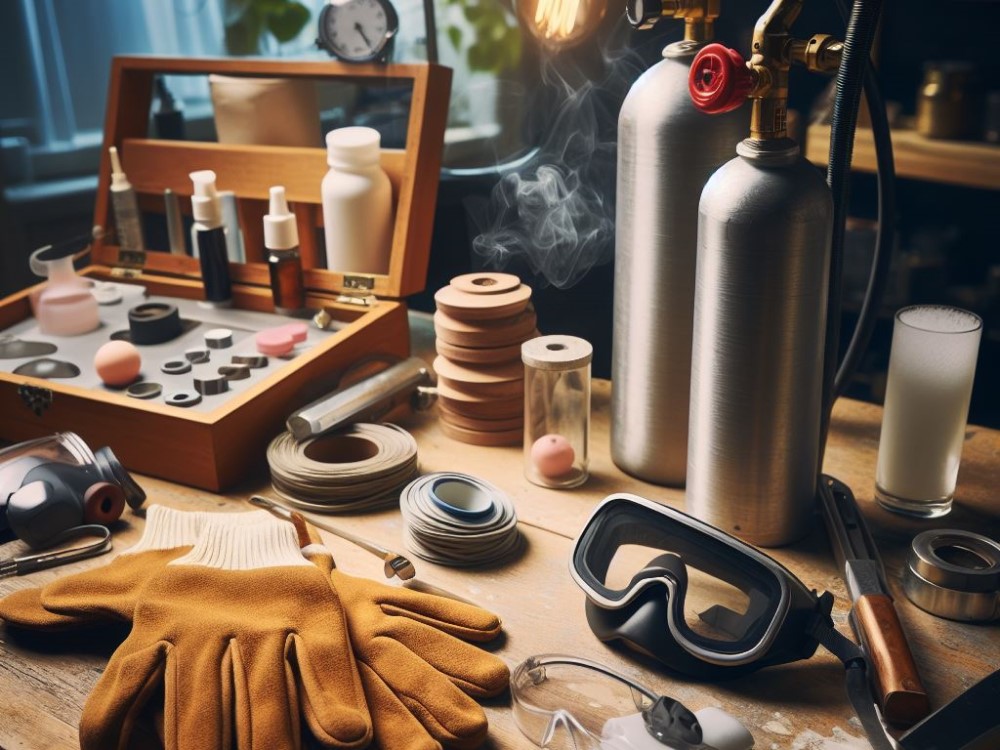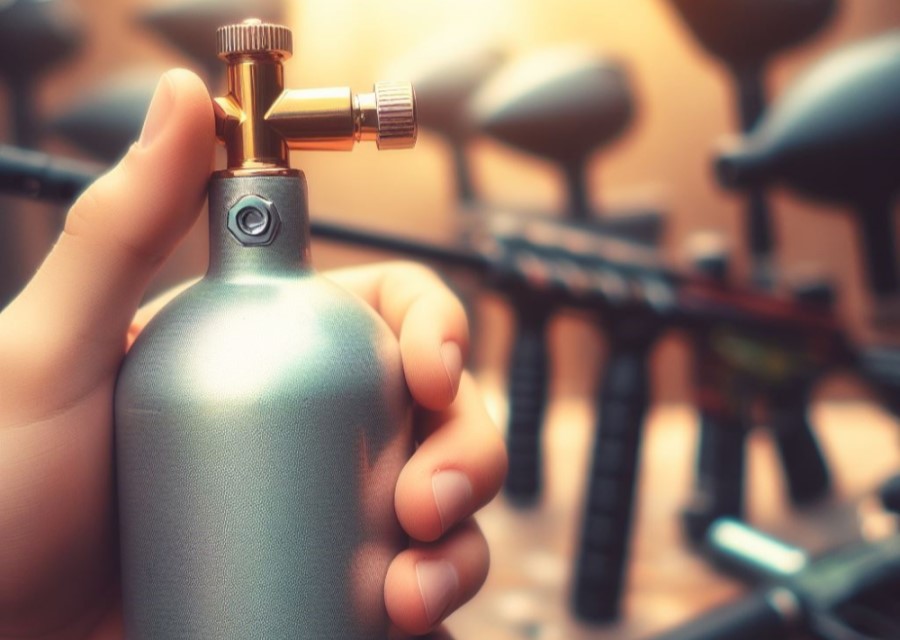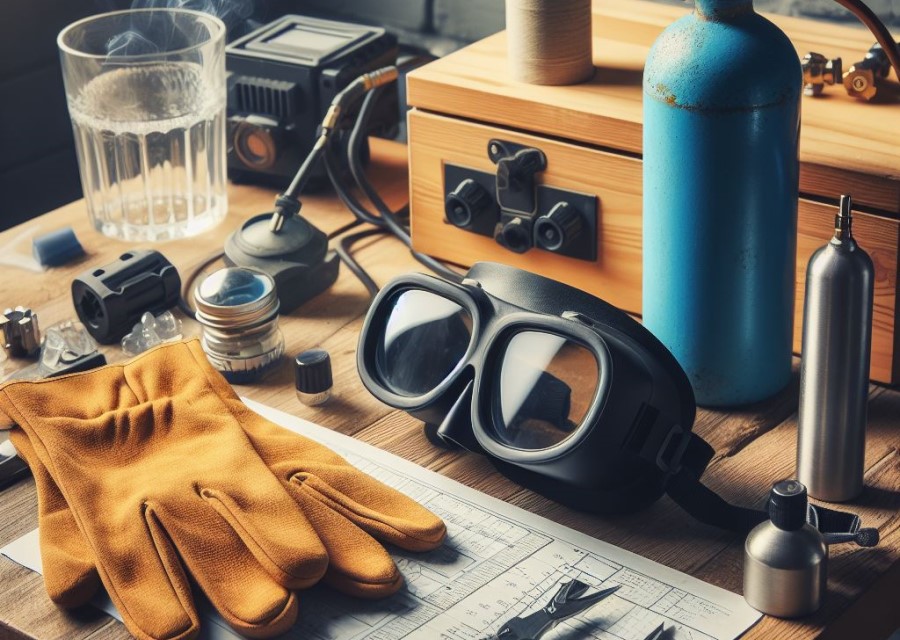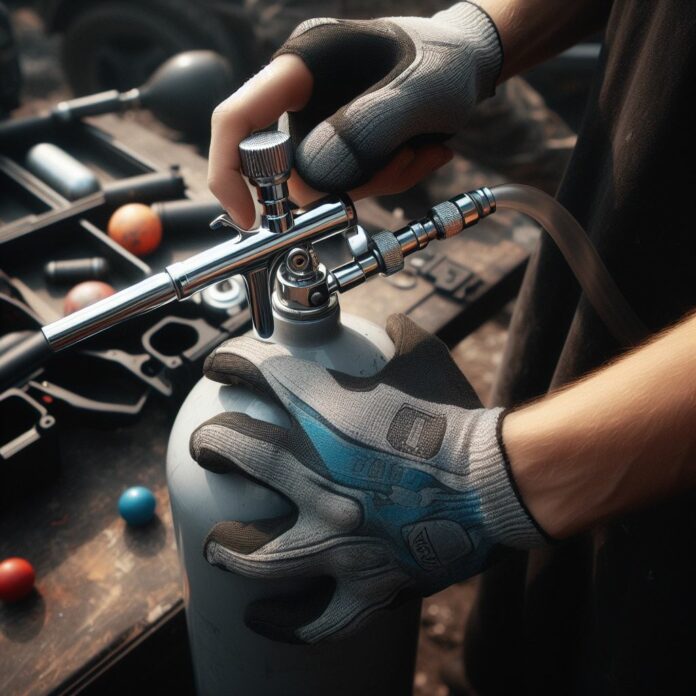Filling a paintball CO2 tank is an essential skill for any paintball enthusiast. Understanding the proper procedure and using the right equipment is crucial for a safe and successful fill. In this article, we will guide you through the step-by-step process on how to fill a paintball CO2 tank and provide helpful tips and precautions to ensure a smooth experience.
To begin, let’s get familiar with the necessary equipment and materials you will need for this task. These include a paintball CO2 tank, a CO2 fill station, a CO2 cylinder, and safety equipment.
Now, let’s dive into the steps involved in filling a paintball CO2 tank. These steps include safety precautions, attaching the CO2 fill station, connecting the CO2 cylinder, opening the cylinder valve, slowly filling the CO2 tank, closing the cylinder valve, detaching the CO2 cylinder, and inspecting and safely storing the filled CO2 tank.
Throughout the process, it is important to follow the manufacturer’s instructions and take precautions such as checking for leaks and avoiding overfilling. we will provide tips on proper disposal of disposable CO2 canisters.
By following these guidelines and taking necessary precautions, you can confidently fill your paintball CO2 tank and ensure a safe and enjoyable paintball experience.
What You Will Need

When it comes to filling a paintball CO2 tank, being prepared is key. In this section, we’ll uncover the essential items you’ll need to get the job done right.
From the paintball CO2 tank itself, to the necessary CO2 fill station, cylinder, and safety equipment, we’ll dive into each sub-section to ensure you have all the tools required for a smooth and successful CO2 tank filling process.
So, let’s get equipped and ready to go!
1. Paintball CO2 Tank
When it comes to filling a paintball CO2 tank, there are a few key steps to follow:
- Safety Precautions: Before starting the filling process, make sure to wear appropriate safety equipment such as goggles and gloves.
- Attach the CO2 Fill Station: Connect the CO2 fill station to the paintball CO2 tank securely.
- Connect the CO2 Cylinder: Attach the CO2 cylinder to the fill station, ensuring a tight connection.
- Open the Cylinder Valve: Slowly open the cylinder valve to allow the CO2 gas to begin filling the paintball CO2 tank.
- Slowly Fill the CO2 Tank: Monitor the filling process and fill the tank slowly to avoid overfilling.
- Close the Cylinder Valve: Once the paintball CO2 tank is filled to the desired level, close the cylinder valve.
- Detach the CO2 Cylinder: Disconnect the CO2 cylinder from the fill station.
- Inspect and Safely Store the Filled CO2 Tank: Check for any leaks and ensure the tank is properly sealed before storing it safely.
Remember, always follow the manufacturer’s instructions for filling a paintball CO2 tank and dispose of any disposable CO2 canisters properly. With these steps, you’ll be able to fill your paintball CO2 tank effectively and safely.
2. CO2 Fill Station
Below is a table outlining the components of a CO2 fill station:
| Component | Description |
|---|---|
| 1. CO2 Fill Station | A device used to transfer CO2 from a larger cylinder to a smaller paintball CO2 tank. |
| 2. Connector Hose | A hose that connects the CO2 fill station to the CO2 cylinder. |
| 3. Pressure Gauge | A gauge that measures the pressure inside the CO2 cylinder. |
| 4. On/Off Valve | A valve that allows the flow of CO2 to be controlled. |
Using a CO2 fill station is a safe and convenient way to fill your paintball CO2 tank. It ensures that you can easily transfer the CO2 from a larger cylinder to your paintball tank without any leaks or overfilling.
It also allows you to monitor the pressure using the pressure gauge and control the flow of CO2 with the on/off valve. Make sure to follow the manufacturer’s instructions for your specific CO2 fill station to ensure proper usage.
Fact: Paintball CO2 tanks are typically filled to around 800-900 psi, which is the optimal pressure for efficient use during paintball games.
3. CO2 Cylinder
Below is a table outlining the necessary information about the CO2 Cylinder:
| Column 1 | Column 2 |
|---|---|
| Type of Cylinder | CO2 Cylinder |
| Function | Stores and supplies CO2 gas for filling paintball CO2 tanks |
| Quantity | Varies depending on the size of the cylinder (e.g. 12 oz, 20 oz) |
| Material | Typically made of aluminum or steel |
| Refillable | Yes, can be refilled at designated refill stations |
| Pressure Rating | Varies depending on the specific cylinder (e.g. 1800 psi, 3000 psi) |
Fact: CO2 cylinders are commonly used in paintball to provide the necessary gas for propelling the paintballs out of the marker. They are designed to withstand the high pressures required for efficient and accurate shooting.
4. Safety Equipment
When it comes to filling a paintball CO2 tank, safety equipment is crucial to ensure a safe and successful process. Here is a list of safety equipment you should have:
- Safety Equipment: Wear goggles to protect your eyes from any CO2 leaks or splashes during the filling process. Safety goggles or paintball-specific goggles are recommended.
- Safety Equipment: Use gloves to protect your hands from potential cold burns caused by handling the CO2 tank and cylinder. Insulated gloves or gloves designed for handling compressed gases are suitable options.
- Safety Equipment: It is advisable to wear long-sleeved shirts and pants to protect your skin from direct contact with the CO2 tank and cylinder. Choose comfortable, non-flammable clothing for added safety.
- Safety Equipment: Keep a fire extinguisher nearby in case of any accidental fires. It is essential to have a properly functioning fire extinguisher rated for CO2 fires.
By having these safety equipment items, you can ensure that you are well-prepared to handle any potential hazards while filling your paintball CO2 tank.
Steps to Fill a Paintball CO2 Tank

Photo Credits: Paintballbuzz.Com by Harold Moore
Discover the straightforward process of filling a paintball CO2 tank with ease. From ensuring safety precautions to efficiently attaching the CO2 fill station, connecting the cylinder, and opening the valve, we’ll guide you through each step.
Learn how to carefully fill the CO2 tank, close the valve, detach the cylinder, and inspect the filled tank for a secure storage. Let’s dive into the practical steps needed to have your paintball CO2 tank ready for action!
Step 1: Safety Precautions
When filling a paintball CO2 tank, it is crucial to ensure a safe and successful process.
- For your safety, remember to wear protective goggles or a face mask to shield your eyes and face from potential CO2 spray or leaks.
- It is important to ensure proper ventilation by conducting the filling process in a well-ventilated area or outdoors.
- Before filling, always inspect the CO2 tank for any signs of damage or corrosion.
- To prevent any accidental disconnections, make sure the paintball CO2 tank and the CO2 fill station are securely attached.
- Keep the area clear of any flammable materials, open flames, or sparks to maintain a safe environment.
- Prior to attaching or detaching the CO2 cylinder valve, ensure that it is closed.
- Prevent potential safety hazards by avoiding overfilling the CO2 tank.
- Remember, do not inhale or ingest CO2 as it can be harmful to your health.
By following these safety precautions in Step 1, you will help minimize the risk of accidents or injuries during the process of filling a paintball CO2 tank.
Step 2: Attach the CO2 Fill Station
Follow the following steps in order to properly attach the CO2 fill station to your paintball CO2 tank:
- Make sure that both the CO2 fill station and the paintball CO2 tank are in good condition and free from any damage.
- Position the CO2 fill station on a stable surface, ensuring that it is secure and will not tip over while you fill it.
- Take off the protective cap from the CO2 fill station valve to reveal the filling port.
- Align the nozzle of the paintball CO2 tank with the filling port of the CO2 fill station.
- Insert the nozzle firmly into the filling port, making sure that it forms a tight seal.
- Use the appropriate tool, such as a wrench or a knob, to securely fasten the nozzle in place.
By following these steps, you will be able to attach the CO2 fill station to your paintball CO2 tank correctly, ensuring a secure and safe connection during the filling process.
Step 3: Connect the CO2 Cylinder
In order to fill a paintball CO2 tank, you need to follow a series of steps. Here is a step-by-step guide on how to connect the CO2 cylinder:
- Ensure that the CO2 cylinder is securely in place and properly aligned with the fill station.
- Locate the valve on the CO2 cylinder and ensure that it is closed.
- Inspect the thread on the CO2 cylinder and the fill station to ensure they are clean and free from damage.
- Carefully attach the CO2 cylinder to the fill station by twisting it clockwise until it is securely in place.
- Double-check that the connection is tight and there are no leaks.
- Verify that the valve on the CO2 cylinder is still closed.
It is important to follow these steps carefully to ensure a safe and successful connection of the CO2 cylinder. Incorrect or loose connections can lead to leakage or other safety hazards.
Step 4: Open the Cylinder Valve
When filling a paintball CO2 tank, it is crucial to follow a series of steps to ensure safety and success. With caution, turn the cylinder valve counterclockwise to open it. This action facilitates the flow of CO2 gas into the paintball CO2 tank for optimal performance.
- Step 1: Safety Precautions – Before commencing the filling process, prioritize your safety by wearing appropriate equipment, such as gloves and safety goggles.
- Step 2: Attach the CO2 Fill Station – Connect the CO2 fill station firmly to the paintball CO2 tank.
- Step 3: Connect the CO2 Cylinder – Affix the CO2 cylinder to the CO2 fill station securely.
- Step 4: Open the Cylinder Valve – With caution, turn the cylinder valve counterclockwise to open it. This action facilitates the flow of CO2 gas into the paintball CO2 tank for optimal performance.
- Step 5: Slowly Fill the CO2 Tank – Monitor the pressure gauge on the fill station closely and gradually fill the paintball CO2 tank to your desired pressure level.
- Step 6: Close the Cylinder Valve – Once the tank is sufficiently filled, turn the cylinder valve clockwise to close it and halt the CO2 gas flow.
- Step 7: Detach the CO2 Cylinder – Disconnect the CO2 cylinder from the CO2 fill station carefully.
- Step 8: Inspect and Safely Store the Filled CO2 Tank – Before storing the paintball CO2 tank securely, conduct a thorough inspection to identify any leaks or damages.
Step 5: Slowly Fill the CO2 Tank
- Ensure the CO2 fill station and CO2 cylinder are securely attached to the paintball CO2 tank.
- Open the valve on the CO2 cylinder slowly to release the gas into the CO2 tank.
- Monitor the pressure gauge on the CO2 fill station to ensure the tank is filling slowly and steadily.
- Slowly fill the CO2 tank until it reaches the desired pressure, which is typically indicated on the tank or recommended by the manufacturer.
- Be cautious not to overfill the CO2 tank, as this can lead to safety hazards or damage to the tank.
- Once the tank is filled to the desired pressure, close the valve on the CO2 cylinder to stop the flow of gas.
- Disconnect the CO2 cylinder from the CO2 fill station and remove the tank from the fill station.
- Inspect the filled CO2 tank for any leaks or damage before storing it safely until it is ready to be used.
Step 6: Close the Cylinder Valve
- Make sure that the CO2 tank is properly connected to the fill station and that the cylinder valve is open.
- Gently twist the cylinder valve in a clockwise direction until it is fully closed.
- Be cautious not to over-tighten the valve to avoid damaging the threads.
- Inspect the valve and connections for any signs of gas leakage. If a leak is detected, repeat the process starting from step 2.
- Once the cylinder valve is closed securely and there are no leaks, disconnect the CO2 cylinder by unscrewing it counterclockwise from the fill station.
- Store the filled CO2 tank in a cool, dry, and well-ventilated area.
- Thoroughly examine the tank for any damage or dents that may pose safety concerns. If any damage is found, refrain from using the tank and seek professional advice.
- Ensure that the stored CO2 tank is kept away from open flames, sources of heat, and flammable materials.
Step 7: Detach the CO2 Cylinder
To successfully detach the CO2 cylinder from a paintball CO2 tank, follow these steps:
- Maintain safety precautions: Prior to detaching the CO2 cylinder, make sure you are wearing the appropriate safety equipment.
- Inspect the area: Check the surrounding area thoroughly to ensure there are no potential hazards or obstructions that could interfere with the process of detaching the CO2 cylinder.
- Secure the tank: It is essential to stabilize and securely place the paintball CO2 tank to avoid any accidents during the detachment process.
- Release pressure: Before proceeding with detaching the CO2 cylinder, it is crucial to release any remaining pressure in the tank. Slowly open the cylinder valve to accomplish this step.
- Detach the cylinder: With utmost care, unscrew or disconnect the CO2 cylinder from the tank. Ensure that you have a firm grip on the cylinder to prevent any accidental drops.
- Store the cylinder: After detaching the CO2 cylinder, store it properly in a safe and designated area. This responsible action will help prevent any damage or accidents.
By following these steps diligently, you will be able to detach the CO2 cylinder from a paintball CO2 tank safely. Always remember to prioritize safety and adhere to the manufacturer’s instructions throughout the entire process.
Step 8: Inspect and Safely Store the Filled CO2 Tank
In order to safely store the filled CO2 tank, follow these steps:
- Check for any leaks or signs of damage on the tank. Make sure the tank is fully sealed and secure.
- Inspect the pressure gauge to ensure it is within the recommended range. The pressure should be stable and not fluctuating too much.
- Securely close the cylinder valve to prevent any gas from escaping. Double-check that it is tightly closed.
- Store the CO2 tank in a cool and dry place, away from direct sunlight or heat sources. Avoid placing it near any flammable materials.
- Keep the tank upright and in an upright position to prevent any potential damage or leakage.
- Store the CO2 tank in an area that is easily accessible but also out of reach of children or unauthorized individuals.
- If possible, label the tank with the date it was filled to ensure you remember when it needs to be refilled or checked for maintenance.
- Inspect and safely store the filled CO2 tank.
Tips and Precautions

Photo Credits: Paintballbuzz.Com by Harold Davis
When it comes to filling a paintball CO2 tank, there are some important tips and precautions to keep in mind. So, let’s jump right into it!
First, we’ll go over the importance of following the manufacturer’s instructions to ensure a safe and effective fill-up. Then, we’ll explore how to check for leaks and prevent any potential mishaps.
Next up, we’ll discuss the dangers of overfilling and why it’s crucial to avoid it. And finally, we’ll cover the proper disposal of disposable CO2 canisters.
Stay tuned for these valuable insights to make your paintball CO2 tank filling experience smooth and hassle-free!
1. Follow Manufacturer’s Instructions
When filling a paintball CO2 tank, it is essential to follow the manufacturer’s instructions to ensure proper and safe usage. Here are the steps to follow:
- Before beginning the filling process, carefully read and understand the manufacturer’s instructions provided with the CO2 tank and fill station.
- Gather all the necessary equipment, including the paintball CO2 tank, CO2 fill station, CO2 cylinder, and safety equipment.
- Ensure that you are working in a well-ventilated area and have proper safety gear, such as gloves and goggles.
- Attach the CO2 fill station securely to the CO2 cylinder according to the manufacturer’s instructions.
- Connect the CO2 cylinder to the paintball CO2 tank using the appropriate fittings.
- Open the cylinder valve slowly to allow the CO2 to flow into the tank.
- Fill the CO2 tank slowly, taking care not to overfill it. Refer to the manufacturer’s instructions for the recommended fill limit.
- Once the tank is filled, close the cylinder valve tightly to stop the flow of CO2.
- Detach the CO2 cylinder from the paintball CO2 tank.
- Inspect the filled CO2 tank for any leaks or damage. Store the tank safely, following the manufacturer’s instructions.
Remember, following the manufacturer’s instructions is crucial to ensure safe filling and usage of the paintball CO2 tank. Always prioritize safety and take necessary precautions.
2. Check for Leaks
When filling a paintball CO2 tank, it’s important to check for leaks to ensure safe and effective operation.
- Turn off the CO2 cylinder valve before checking for leaks.
- Apply a thin layer of soapy water to the connection points between the CO2 fill station and the CO2 tank.
- Observe for any bubbles or foaming, as this indicates a leak in the connection.
- If a leak is detected, tighten the connection or replace any damaged seals.
- Repeat the process of applying soapy water to the connections and checking for leaks until no bubbles or foaming is observed.
- Once no leaks are present, you can proceed with filling the CO2 tank using the appropriate steps.
Checking for leaks is crucial to ensure that the CO2 tank is properly sealed and that no gas is escaping during the filling process. This helps maintain the safety and efficiency of the paintball CO2 tank.
3. Avoid Overfilling
To ensure a safe and proper fill for your paintball CO2 tank, it is crucial to avoid overfilling. Follow these steps to prevent potential accidents or damage:
1. Securely attach the CO2 tank to the CO2 fill station.
2. Connect the CO2 cylinder to the fill station.
3. Slowly open the cylinder valve to allow the CO2 to flow into the tank.
4. Monitor the pressure gauge on the fill station to prevent overfilling.
5. Once the desired pressure is reached, close the cylinder valve.
6. Detach the CO2 cylinder from the fill station.
7. Inspect the filled CO2 tank for any leaks or issues.
8. Safely store the filled CO2 tank following proper storage guidelines.
Remember, these steps are provided as a general guideline. Always refer to the manufacturer’s instructions and guidelines specific to your paintball CO2 tank and fill station for a successful and safe fill. Handle the process with caution and regularly check the pressure gauge to prevent any mishaps.
4. Properly Dispose of Disposable CO2 Canisters
When it comes to the proper disposal of disposable CO2 canisters, it is important to follow these steps:
- Check local regulations: Before disposing of the canisters, it is crucial to ensure that you are following the proper procedures for the proper disposal of disposable CO2 canisters.
- Release remaining CO2: If there is any CO2 remaining in the canister, make sure to safely release it by attaching it to a compatible CO2 tank and slowly opening the valve to properly dispose of disposable CO2 canisters.
- Empty canister into a designated container: To prevent any environmental harm, empty the contents of the canister into a designated container, such as a CO2 collection bin, as part of the process to properly dispose of disposable CO2 canisters.
- Remove pressure: Once the canister is empty, it is crucial to remove any remaining pressure from the canister to prevent accidental releases. This can be done by pressing on the valve or using a tool to release the pressure, following the steps to properly dispose of disposable CO2 canisters.
- Recycle or dispose of properly: To determine the proper method of disposal for the canisters, it is essential to check with your local recycling or hazardous waste facility. They may require the canisters to be recycled or disposed of as hazardous waste as part of the process to properly dispose of disposable CO2 canisters.
By following these steps, you can ensure that disposable CO2 canisters are properly disposed of, reducing any potential environmental impact and properly disposing of disposable CO2 canisters.
Frequently Asked Questions
How do I fill a paintball CO2 tank at a paintball field?
To fill a paintball CO2 tank at a paintball field, you can simply visit the field’s filling station. Connect the line from the CO2 tank to the fill station and slowly release the air until the tank is full.
Can I refill my paintball CO2 tank at a bicycle shop or a sporting goods store?
Yes, some bicycle shops and sporting goods stores do offer CO2 tank refills. However, it is important to note that there may be a risk of overfilling if an inexperienced person helps with the process. It is best to check with the store beforehand to ensure they provide CO2 tank refilling services.
Where else can I get my paintball CO2 tank filled besides paintball stores and fields?
You can also get your paintball CO2 tank filled at businesses that fill fire extinguishers, local home brew shops, scuba diving equipment supply shops, and some sporting stores that sell paintball guns. It is recommended to call and confirm with these places before going.
How often do paintball tanks need to be retested for safety?
Paintball tanks need to be retested for safety every 3-5 years. This ensures that the tank is still able to withstand the pressure and does not have any leaks or faults that could pose a safety risk during use.
Is it possible to convert a paintball gun using a CO2 tank to compressed air?
Yes, it is possible to convert a paintball gun that uses a CO2 tank to compressed air. This can be done by using an ASA adapter to connect the compressed air tank to the paintball gun. However, it is important to ensure that the paintball gun is compatible with compressed air before attempting the conversion.
Which is better for paintball, CO2 or compressed air?
Both CO2 and compressed air have their advantages and disadvantages for paintball. CO2 tanks are cheaper and more common for beginners, while compressed air tanks are more expensive and used by advanced players. Compressed air is more consistent, especially in cold weather, and is better for electronic guns. However, it is also more expensive than CO2 and requires heavy-duty compression. Ultimately, the choice between CO2 and compressed air depends on individual preferences and playing style.

